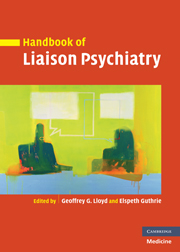Book contents
- Frontmatter
- Contents
- List of contributors
- Preface
- Part I Basic skills
- Part II Common psychiatric problems across the general hospital
- Part III Working with specific units
- 14 Neurological disorders
- 15 Cardiorespiratory disorders
- 16 Gastrointestinal disorders
- 17 Liver disorders
- 18 Endocrine disorders
- 19 Diabetes
- 20 HIV and AIDS
- 21 Renal disease
- 22 Musculo-skeletal disorders
- 23 Oncology
- 24 Head and neck cancer
- 25 Palliative care
- 26 Cosmetic procedures
- 27 Perinatal and gynaecological disorders
- 28 The intensive care unit
- 29 The burns unit
- 30 Psychocutaneous disorders
- 31 Genitourinary disorders
- 32 The emergency department
- Part IV Treatment
- Part V Different treatment settings
- Index
- References
31 - Genitourinary disorders
from Part III - Working with specific units
Published online by Cambridge University Press: 10 December 2009
- Frontmatter
- Contents
- List of contributors
- Preface
- Part I Basic skills
- Part II Common psychiatric problems across the general hospital
- Part III Working with specific units
- 14 Neurological disorders
- 15 Cardiorespiratory disorders
- 16 Gastrointestinal disorders
- 17 Liver disorders
- 18 Endocrine disorders
- 19 Diabetes
- 20 HIV and AIDS
- 21 Renal disease
- 22 Musculo-skeletal disorders
- 23 Oncology
- 24 Head and neck cancer
- 25 Palliative care
- 26 Cosmetic procedures
- 27 Perinatal and gynaecological disorders
- 28 The intensive care unit
- 29 The burns unit
- 30 Psychocutaneous disorders
- 31 Genitourinary disorders
- 32 The emergency department
- Part IV Treatment
- Part V Different treatment settings
- Index
- References
Summary
Introduction
Genitourinary medicine attracted the attention of liaison psychiatrists decades before the emergence of HIV. Although many psychiatrists are accustomed to working in HIV departments, fewer contemporary practitioners have experience of general genitourinary medicine (GUM) clinics. Psychiatric sequelae of HIV are described separately in Chapter 20, allowing this chapter to focus specifically on other genitourinary diseases, which deserve both clinical and research emphasis within liaison psychiatry. The focus is on conditions such as genital herpes, gonorrhoea, genital warts, chlamydia and non-specific urethritis. The journey includes historical concepts such as ‘syphilophobia’, mutations of which retain relevance today. A wealth of studies in the 1970s and 1980s demonstrated disproportionate rates of common mental illness in genitourinary medicine outpatients and these rates persist into modern times. As in other fields of medicine, much of this morbidity goes unrecognized. The primary psychiatric diagnoses that may present in the GUM setting are discussed, before examining some of the causes, and the implications for treatment and service development.
The historical perspective and syphilophobia
As a sexually transmitted disease, syphilis held a uniquely prominent position in psychiatry during the nineteenth and twentieth centuries. Before penicillin (the treatment of choice for the condition) approximately 10% of new psychiatric inpatients were diagnosed with neurosyphilis (Hutto 2001). General paresis of the insane was a devastating condition appearing many years after the initial syphilitic infection. It rendered the patient demented and physically incapacitated, although the exact psychiatric presentation of the disease varied from case to case.
Keywords
- Type
- Chapter
- Information
- Handbook of Liaison Psychiatry , pp. 733 - 750Publisher: Cambridge University PressPrint publication year: 2007

